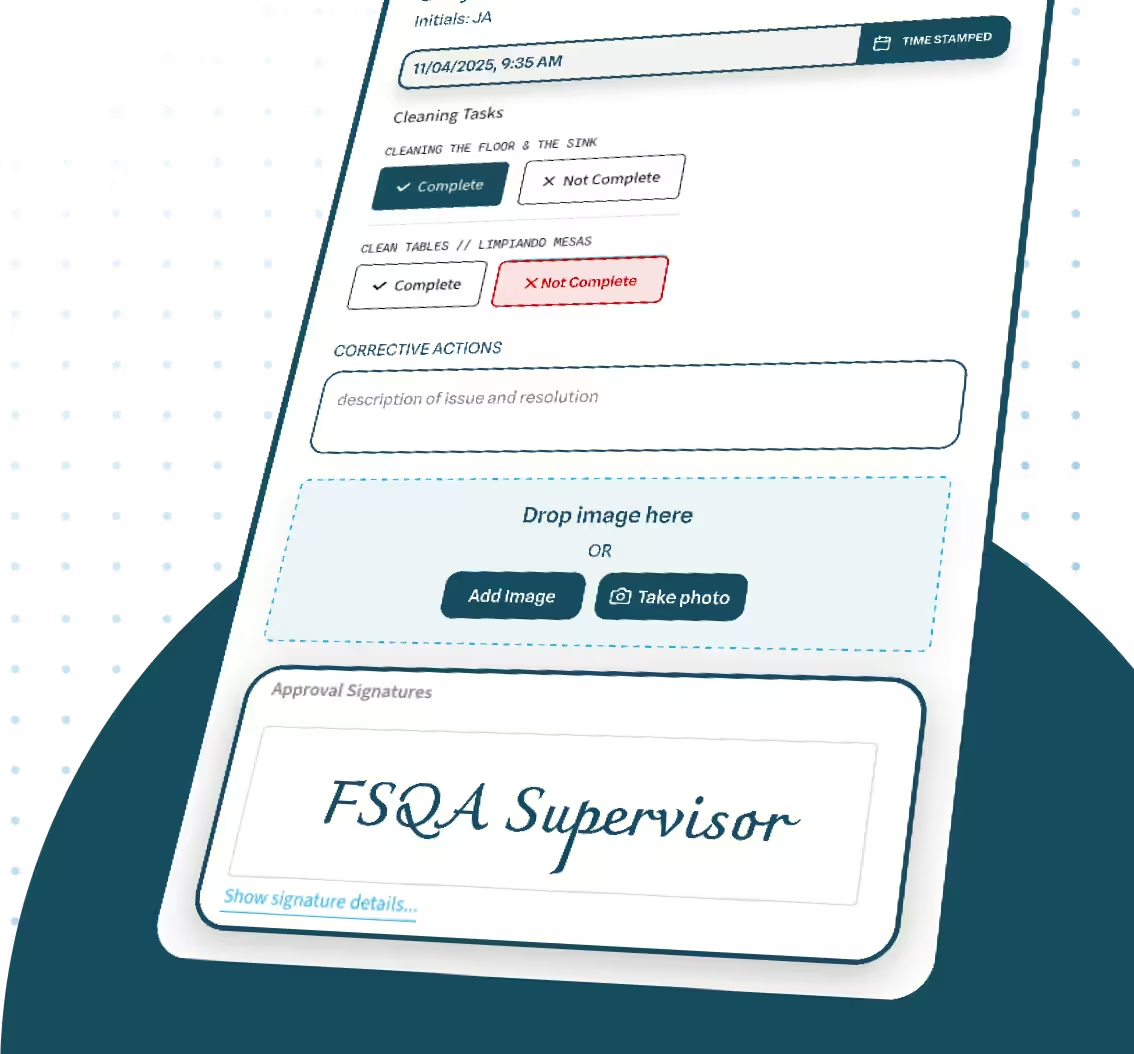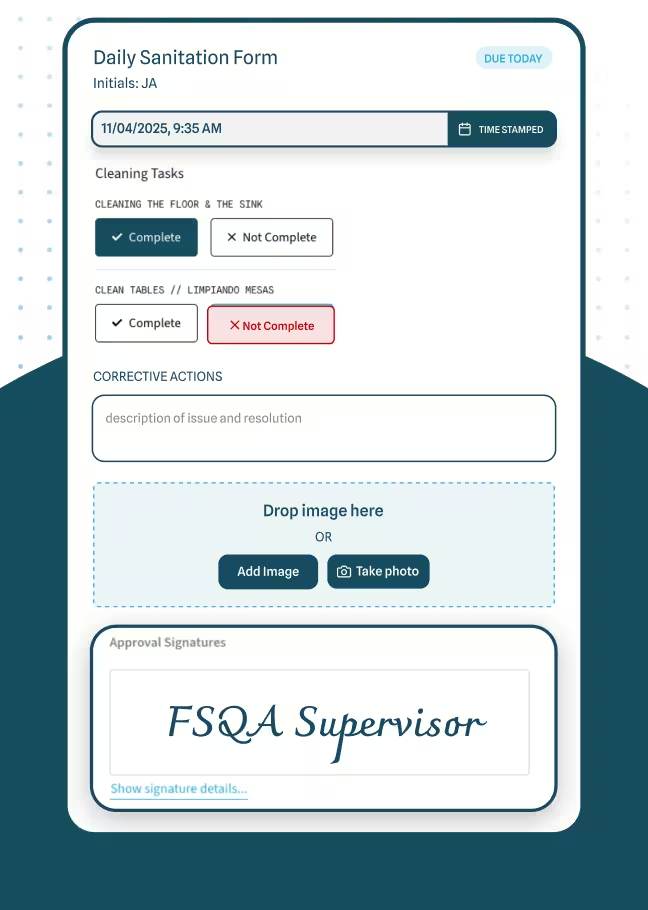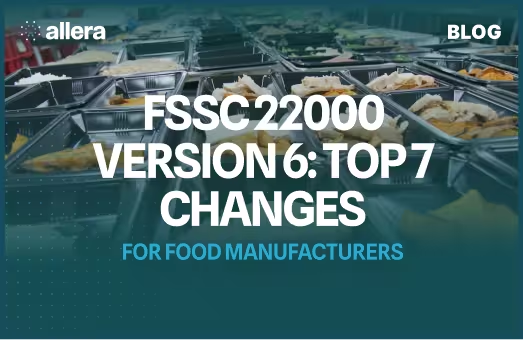

SQF (Safe Quality Food): Full Guide for Food Manufacturers

Key Takeaways:
- SQF is a globally recognized food safety standard that builds trust, credibility, and market access.
- Three main certification options—Fundamentals, Food Safety Code, and Quality Code—fit different business needs.
- Leadership commitment and a HACCP-based plan are essential for qualification.
- Gap analysis and audit preparation are key steps to getting certified.
- Continuous improvement and digital tools help maintain certification.
TL;DR: This guide shows how SQF helps food manufacturers meet global safety standards, gain trust, and expand into new markets. It explains the three certification levels, core requirements, and practical steps for implementation and audit readiness. With strong leadership, clear documentation, and the right technology, SQF can become a long-term competitive advantage rather than just a compliance task.
What is SQF Certification and Why Do Food Manufacturers Need It?
Safe Quality Food, or SQF, is a global food safety and quality standard administered by the SQF Institute and recognized by the Global Food Safety Initiative (GFSI). The standard helps ensure that a facility’s manufacturing and processing practices meet stringent requirements for product safety, cleanliness, labeling, traceability, and consumer confidence. For food manufacturers, achieving SQF certification confers several advantages, including enhanced brand credibility, streamlined operations, and greater market expansion possibilities.
Furthermore, SQF encourages a continuous improvement mindset, honing processes and instilling accountability at every operational tier. Companies that adopt this framework typically aim to:
- Mitigate internal and external audit risks.
- Foster consumer and partner trust by adhering to consistent, high-level quality and safety metrics.
- Comply with local and international regulations, facilitating smoother cross-border transactions.
- Maintain a competitive edge by validating product safety claims.
For many, the initial complexity may appear daunting. While core principles such as Hazard Analysis and Critical Control Point (HACCP) plans are standard in other programs, SQF’s clear documentation requirements and mandatory auditing criteria offer a structured—albeit detailed—approach to ensuring products are safe and processes are effectively managed.
What Are the Different SQF Levels and Which One Do I Need?
The SQF framework is organized into several distinct codes and levels to suit different segments of the food and beverage supply chain, from primary production to manufacturing and distribution. The codes address processes within food businesses large and small, helping them meet internationally recognized safety norms. Selecting the correct code for one’s operation and understanding the relevant levels is essential for proper certification. (See the SQF Codes Library and the Code Selector.)
SQF Fundamentals Program
This entry-level program is aimed at small- and medium-sized enterprises that need a stepping stone into globally recognized food safety certifications. It focuses on teaching the basics of safe food handling, recordkeeping practices, sanitation, and preliminary hazard analysis. Companies beginning their journey might opt for this streamlined approach before moving on to the full Food Safety Code.
SQF Food Safety Code
More advanced than the Fundamentals Program, the SQF Food Safety Code encompasses a range of modules tailored to specific areas of the food industry, such as processing, packaging, storage, and distribution. This code enforces rigorous hazard analysis protocols, corrective action processes, and validated preventive controls to minimize contamination risks. Because it is benchmarked by GFSI, this level is widely acknowledged by regulators, retailers, and consumers worldwide.
SQF Quality Code
Designed to elevate safety practices to premium quality standards, the SQF Quality Code includes performance metrics and robust quality management principles. Certifying to the Quality Code demonstrates not only compliance but also a commitment to product consistency and excellence.
Grouping these codes provides a clear roadmap for facilities, enabling them to identify how best to integrate SQF requirements. The choice depends on current operational maturity, target markets, and desired brand positioning in terms of unwavering consumer confidence.
What Are the Core SQF Requirements for Food Manufacturing Compliance?
At the heart of the SQF program lies a set of fundamental elements that every certified facility must comply with. Typically, these requirements involve:
- Management Commitment: Senior leaders must actively endorse the initiative, allocate sufficient resources, and model adherence to safety and quality assurance protocols.
- Documented Food Safety Plan: A structured plan grounded in HACCP principles guides hazard analysis and preventive controls. This plan must be reviewed regularly to remain effective.
- Product and Process Controls: Critical control points must be identified, monitored, and validated to confirm that hazards are mitigated.
- Verification and Validation: Internal and external audits, alongside routine monitoring, ensure that preventive measures are achieving the intended results. If results are not satisfactory, revised actions are implemented.
- Traceability and Recall Procedures: In case of a contaminant or other concern, a quick and thorough product recall plan is essential to protect consumers and minimize brand damage (see FDA’s Industry Guidance for Recalls).
- Training and Competency: Personnel at all levels, especially those who handle sensitive production aspects, require targeted training and ongoing skill development.
By fully integrating these elements into daily operations, companies can minimize disruptions that come from sudden recall incidents or non-compliances identified by inspectors. Moreover, an organization gains significant agility to respond to emerging threats or new regulations.
How to Develop and Implement an SQF Plan?
Implementing a robust SQF plan requires a systematic approach that begins with a comprehensive gap analysis and culminates in a cycle of continuous improvement. The plan is typically tailored to the specific nature of the manufacturing process, facility scale, and product complexity.
Conduct a gap analysis
Before proceeding with plan documentation, companies typically conduct a thorough review of their existing food safety measures to identify any shortfalls with respect to the SQF Code. This diagnostic process includes reviewing operational metrics, hazard identification strategies, and current documentation. For many food manufacturing sites, a gap analysis reveals not only deficits in compliance but also potential oversights in day-to-day oversight.
Secure management buy-in
SQF certification demands significant time and investment, so it is essential that top executives broadly support the initiative. Allocating budget for technology upgrades, staff training, and ongoing audits is part of ensuring that the plan does not stall due to resource constraints. Based on our experience, teams that receive strong leadership support can streamline their compliance journey and more effectively tackle unforeseen obstacles.
Draft documentation
Developing well-structured Standard Operating Procedures (SOPs), a rigorous HACCP plan, and associated policies is critical to successful certification. Each document must align with SQF requirements, detailing how hazards and subsequent controls are identified, monitored, and verified. Procedures covering traceability, sanitation, allergen handling, and corrective action processes also form part of the documentation.
Tip: When you’re ready to move beyond binders, Allera’s Document Control gives you version tracking, approvals, audit trails, and read-and-understand acknowledgements in one place—purpose-built for audits like SQF.
Strengthen employee training
Any plan is only as strong as the employees who implement it. Companies that invest in comprehensive training programs, job-specific instructions, and ongoing skill refreshers see fewer compliance loopholes. Managers gain clarity on responsibilities, and front-line teams understand how to detect and respond to deviations in a timely manner.
How to Prepare for an SQF Audit?
After drafting the SQF plan and integrating it into daily routines, an organization typically proceeds to a third-party certification SQF audit. The prospect of external auditors scrutinizing every detail can be daunting, yet proper preparation significantly boosts the chances of success.
- Internal Audits: Before scheduling a certification audit, we recommend conducting regular internal audits to verify conformance with all SQF requirements. An internal audit team, or an experienced consultant, checks for compliance and applies corrective actions.
- Mock Audits: A practice audit or pre-assessment review directed by a qualified auditor can highlight areas still needing improvement. Employing checklists replicates real-world auditing conditions and builds employee confidence.
- Audit Readiness: Maintaining organized documentation is vital. Recipes, quality control logs, temperature records, and cleaning schedules should be easily accessible for inspectors’ review. (See SQFI’s Certification Overview for what auditors typically expect.)
Nevertheless, maintaining consistent processes is not adequate on its own. All employees, especially those on the production floor, should be ready to explain or demonstrate the procedures they follow. Auditors frequently ask for evidence of policy communication, tracking logs, and training records, so ensuring that the entire team is confidently prepared is critical.
How to Maintain Compliance After Certification
SQF certification is not a final destination but rather the beginning of a continuous journey. Food safety threats and market demands evolve, prompting organizations to constantly reassess and refine their controls. A well-managed compliance program involves scheduled reviews, frequent updates to risk assessments, and proactive engagement with industry shifts. Many teams reference the FDA’s Compliance Manuals to align ongoing practices with enforcement expectations.
- Scheduled Reassessments: Regularly revisit the HACCP plan, especially during product changes or expansions.
- Corrective and Preventive Actions: Every time non-conformance is discovered, it is vital to correct the issue and document the resolution steps.
- Performance Tracking: Monitoring performance metrics, such as the frequency of deviations, can pinpoint everyday challenges and guide adjustments in training or procedures.
- Emerging Risks: Global supply chains are inherently more complex, and new contaminants can arise. Consequently, it is essential to keep hazard profiles updated and adapt controls accordingly.
By integrating a robust review cycle, companies can ensure that they remain audit-ready while upholding high standards of food safety and quality.
Tip: If you're considering software options to help with SQF compliance, read our article covering SQF software and why it's essential for food manufacturers in 2025.
Most Common SQF Certification Challenges and How to Overcome Them
Although SQF offers a clear roadmap for food safety, achieving and maintaining certification can pose hurdles for many manufacturers. Recognizing them in advance can minimize disruptions and help plan more effectively.
- Limited Employee Engagement: Without active participation from frontline workers, new protocols can fail. An inclusive training strategy that emphasizes day-to-day relevance is integral for success.
- Documentation Overload: SQF programs involve extensive recordkeeping. Companies lacking a systematic approach to data management can be overwhelmed. Digitizing records often eases administrative burdens.
- Resource Constraints: Some businesses struggle to allocate funds for technology upgrades, facility enhancements, or needed personnel. Balancing initial investments with long-term returns is often a critical step in justifying improvements.
- Resistance to Change: Established plant routines can hamper the adoption of improved safety and quality measures. Overcoming this challenge typically requires active championing by leadership, transparent communication, and structured training.
- Supply Chain Complexity: In some operations, raw materials might come from multiple suppliers across several regions. Ensuring each supplier aligns with SQF requirements demands a strong supply chain management process and regular audits of partners.
Nevertheless, each obstacle can be overcome with a strategic approach, dedicated leadership, and a culture that prizes ongoing improvement. By anticipating these hurdles, organizations can confidently refine their SQF plan, gaining resilience along the way.
Conclusion and next steps
For modern food manufacturing facilities, few credentials carry the weighty significance of SQF certification. The rigor of SQF fosters trust between business partners and consumers alike, elevates operational consistency, and ensures alignment with rapidly evolving food safety standards. As this ultimate guide shows, implementing an SQF program is undoubtedly a substantial undertaking, necessitating high-level commitment, thorough documentation, and a consistent drive for continuous improvement.
Nevertheless, the ability to demonstrate compliance with one of the food industry’s most prominent certifications is more than a competitive advantage. It is a testament to an organization’s commitment to protecting public health, safeguarding brand reputation, and adapting to marketplace expectations. Those businesses that implement robust SQF measures can achieve more efficient production lines, better resource management, and stronger stakeholder trust.
To further optimize these efforts, specialized digital solutions streamline record keeping, automate routine checks, and provide real-time visibility into quality metrics. Our expertise indicates that advanced software helps food manufacturers reduce manual tasks and maintain a higher standard of readiness for unannounced audits and routine certifications. We recommend Allera Technologies software for an integrated approach that centralizes documentation, automates alerts, and ensures every detail is thoroughly monitored. By partnering with the right technology provider, companies can reinforce their food safety and quality commitments and stay prepared for whatever challenges arise.
FAQs
What are SQF prerequisite programs?
SQF prerequisite programs are foundational practices and controls required before implementing SQF food safety plans. These include Good Manufacturing Practices (GMPs), sanitation procedures, pest control, personnel hygiene, equipment maintenance, and supplier verification programs that form the baseline for effective food safety management.
What is the difference between SQF and FDA?
SQF is a voluntary certification program that provides third-party verification of food safety management systems. FDA is a government agency that enforces mandatory food safety laws and regulations. SQF certification helps facilities demonstrate compliance with FDA requirements but operates independently from government oversight.
How many levels of SQF are there?
SQF has three certification levels:
- Level 1 - SQF Fundamentals covering basic food safety practices
- Level 2 - Comprehensive food safety management systems
- Level 3 - Food safety and quality management integration
- What is an SQF Level 3 food facility?
An SQF Level 3 food facility is certified for comprehensive food safety and quality management systems. These facilities demonstrate advanced implementation of both food safety controls and quality assurance programs, representing the highest level of SQF certification available.
Does Costco require SQF certification?
Yes, Costco often requires suppliers to have SQF certification for food products. Many major retailers mandate SQF or equivalent food safety certifications as part of their supplier qualification requirements to ensure product safety and quality standards.
What is the difference between SQF and USDA?
SQF is a food safety management certification program that provides third-party verification of food safety systems. USDA is a government agency that regulates food safety and labeling requirements in the United States. SQF certification helps demonstrate compliance with USDA regulations but operates as an independent standard.
What is a good SQF score?
According to Scores above 85% indicate strong compliance with SQF standards. Facilities achieving 95% or higher demonstrate excellent food safety and quality management practices. Scores below 85% typically require corrective actions and follow-up audits to maintain certification.
What are the three principles of SQF?
The three core principles of SQF (Safe Quality Food) are food safety, quality management, and regulatory compliance.
- Food safety is the foundation of the program, focusing on the prevention of biological, chemical, and physical hazards that can threaten public health. This includes applying HACCP principles, maintaining proper sanitation, and implementing traceability systems to minimize the risk of contamination.
- Quality management ensures that food products are not only safe but also consistent, reliable, and aligned with customer expectations. Through standardized processes, recordkeeping, and continuous improvement, SQF helps businesses reduce waste, improve efficiency, and maintain product integrity across every batch.
- Regulatory compliance guarantees that food companies meet all relevant laws and international standards. This includes alignment with government agencies such as the FDA or USDA in the United States, as well as adherence to global frameworks like GFSI. By doing so, businesses reduce the risk of recalls, penalties, and market restrictions.
Together, these three principles create a comprehensive and integrated food safety management system. They protect consumers, build trust with retailers and buyers, and help businesses remain competitive in a highly regulated global food industry.

.avif)







.avif)

.avif)
